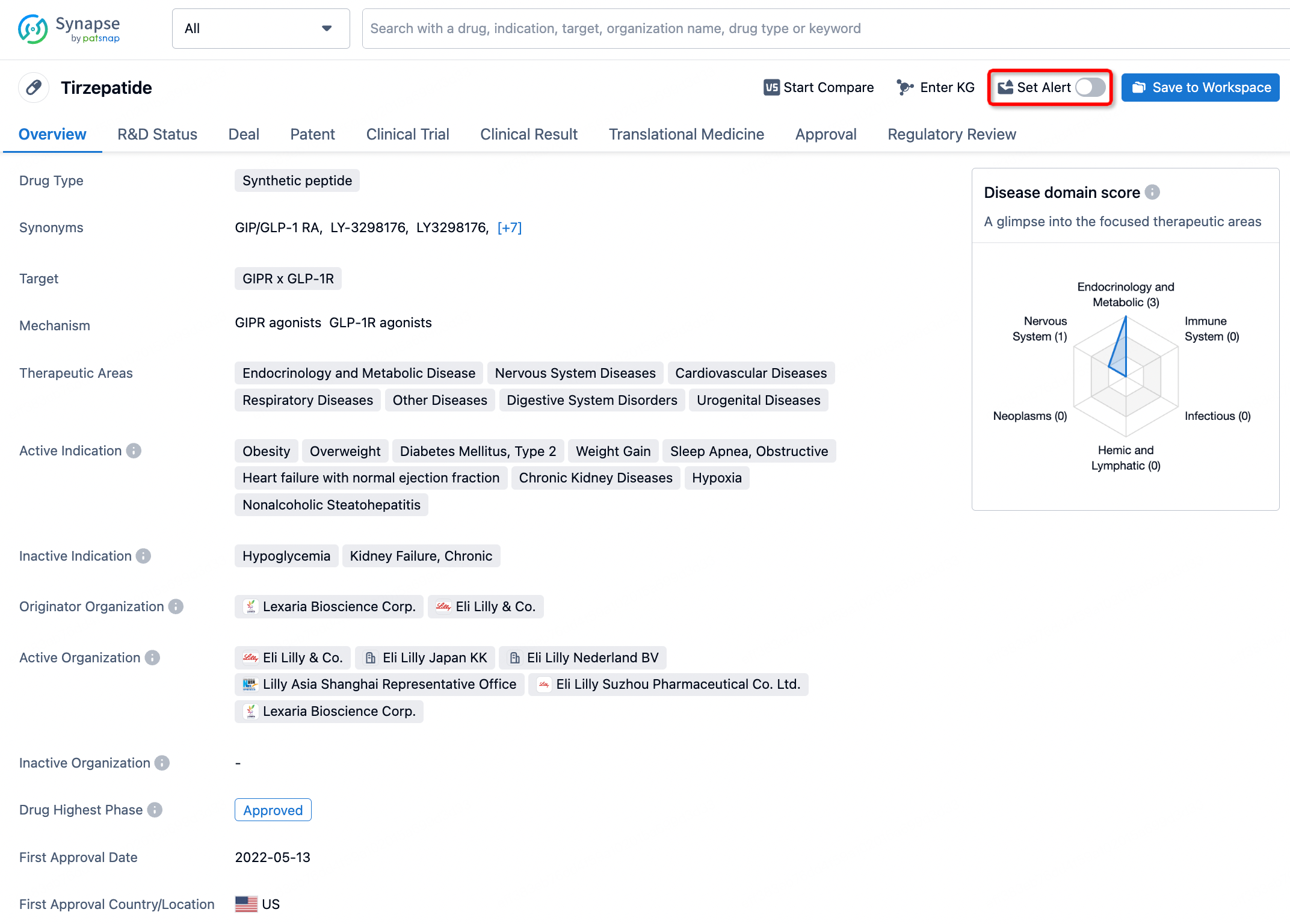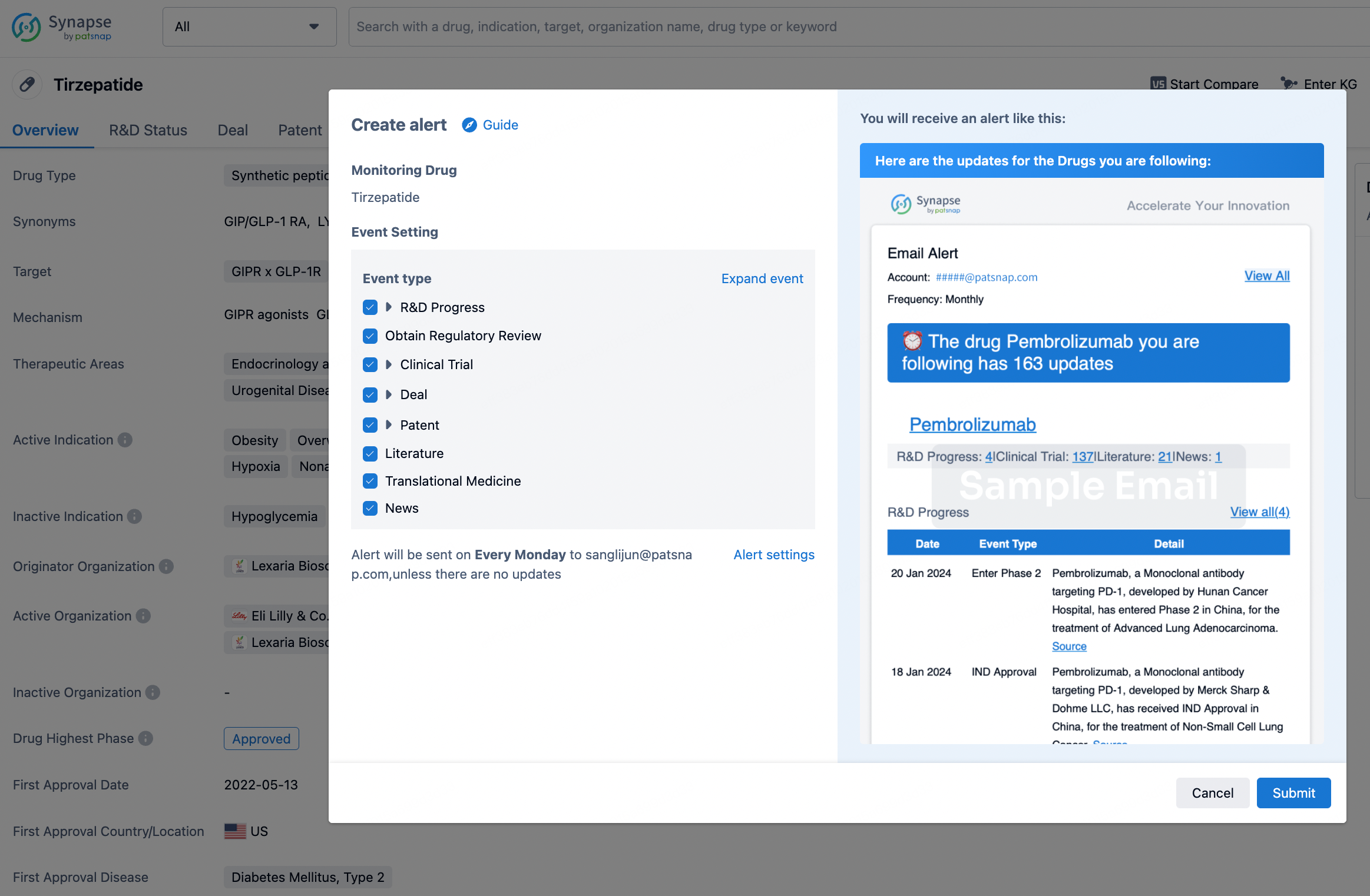Request Demo
What is Olezarsen used for?
28 June 2024
Olezarsen is an emerging therapeutic agent that has captured the attention of the medical and scientific communities due to its promising potential in treating lipid disorders. Developed by Ionis Pharmaceuticals, Olezarsen is a type of antisense oligonucleotide (ASO) designed to target specific RNA molecules involved in lipid metabolism. The drug's primary indication is for the treatment of hyperlipidemia, specifically conditions characterized by elevated levels of triglycerides in the blood, such as Familial Chylomicronemia Syndrome (FCS). FCS is a rare genetic disorder that leads to severe hypertriglyceridemia, often resulting in recurrent episodes of pancreatitis and other serious health complications. Currently, Olezarsen is undergoing various phases of clinical trials, demonstrating significant promise in reducing triglyceride levels and thereby mitigating the risks associated with hyperlipidemia.
The mechanism of action of Olezarsen revolves around its capacity to modulate gene expression. As an antisense oligonucleotide, Olezarsen binds to the mRNA of apolipoprotein C-III (ApoC-III), a protein that plays a crucial role in the regulation of triglyceride metabolism. ApoC-III is known to inhibit lipoprotein lipase (LPL), an enzyme responsible for the hydrolysis of triglycerides in lipoproteins. By binding to the mRNA of ApoC-III, Olezarsen facilitates its degradation via RNase H-mediated cleavage. This process effectively reduces the production of ApoC-III, thereby alleviating its inhibitory effect on LPL. As a result, LPL activity is enhanced, leading to increased breakdown of triglycerides and a subsequent reduction in their serum levels. This targeted approach not only promises to lower triglyceride levels significantly but also minimizes the risk of off-target effects, making it a highly specific and potentially safer therapeutic option.
The primary indication of Olezarsen is for the treatment of hyperlipidemia, with a specific focus on conditions like Familial Chylomicronemia Syndrome (FCS) and severe hypertriglyceridemia. Hyperlipidemia is a broad term encompassing various lipid disorders characterized by abnormal levels of lipids in the blood, including cholesterol and triglycerides. Elevated triglyceride levels are particularly concerning as they are associated with an increased risk of developing cardiovascular diseases, acute pancreatitis, and other metabolic complications. FCS, a rare and severe form of hypertriglyceridemia, is caused by mutations in genes that encode for enzymes or proteins crucial for triglyceride metabolism, such as LPL, ApoC-II, and others. Patients with FCS often present with extremely high triglyceride levels, which can exceed 1000 mg/dL, and are at a significantly heightened risk for recurrent pancreatitis, hepatosplenomegaly, and other complications.
In clinical trials, Olezarsen has demonstrated considerable efficacy in reducing triglyceride levels in patients with FCS and other forms of severe hypertriglyceridemia. One of the key studies evaluating Olezarsen's efficacy was a phase 2 clinical trial, which included patients with FCS and severe hypertriglyceridemia who had not responded adequately to conventional lipid-lowering therapies. The trial results were promising, showing a significant reduction in triglyceride levels, with some patients experiencing up to a 70% decrease. Additionally, Olezarsen was generally well-tolerated, with most adverse events being mild to moderate in severity.
The potential of Olezarsen extends beyond FCS and severe hypertriglyceridemia. Researchers are also exploring its efficacy in other lipid disorders and cardiovascular conditions associated with elevated triglyceride levels. Given the pivotal role that triglycerides play in the pathogenesis of cardiovascular diseases, Olezarsen could emerge as a valuable therapeutic tool in the broader context of cardiovascular risk management. Furthermore, the success of Olezarsen could pave the way for the development of other antisense oligonucleotide therapies targeting different aspects of lipid metabolism and other metabolic disorders.
In conclusion, Olezarsen represents a significant advancement in the treatment of hyperlipidemia, particularly for patients suffering from severe forms of the condition like Familial Chylomicronemia Syndrome. Its targeted mechanism of action offers a promising approach to managing elevated triglyceride levels and reducing the associated health risks. As research progresses, Olezarsen holds the potential to become a cornerstone therapy in lipid disorder management, offering hope to patients who have limited treatment options.
The mechanism of action of Olezarsen revolves around its capacity to modulate gene expression. As an antisense oligonucleotide, Olezarsen binds to the mRNA of apolipoprotein C-III (ApoC-III), a protein that plays a crucial role in the regulation of triglyceride metabolism. ApoC-III is known to inhibit lipoprotein lipase (LPL), an enzyme responsible for the hydrolysis of triglycerides in lipoproteins. By binding to the mRNA of ApoC-III, Olezarsen facilitates its degradation via RNase H-mediated cleavage. This process effectively reduces the production of ApoC-III, thereby alleviating its inhibitory effect on LPL. As a result, LPL activity is enhanced, leading to increased breakdown of triglycerides and a subsequent reduction in their serum levels. This targeted approach not only promises to lower triglyceride levels significantly but also minimizes the risk of off-target effects, making it a highly specific and potentially safer therapeutic option.
The primary indication of Olezarsen is for the treatment of hyperlipidemia, with a specific focus on conditions like Familial Chylomicronemia Syndrome (FCS) and severe hypertriglyceridemia. Hyperlipidemia is a broad term encompassing various lipid disorders characterized by abnormal levels of lipids in the blood, including cholesterol and triglycerides. Elevated triglyceride levels are particularly concerning as they are associated with an increased risk of developing cardiovascular diseases, acute pancreatitis, and other metabolic complications. FCS, a rare and severe form of hypertriglyceridemia, is caused by mutations in genes that encode for enzymes or proteins crucial for triglyceride metabolism, such as LPL, ApoC-II, and others. Patients with FCS often present with extremely high triglyceride levels, which can exceed 1000 mg/dL, and are at a significantly heightened risk for recurrent pancreatitis, hepatosplenomegaly, and other complications.
In clinical trials, Olezarsen has demonstrated considerable efficacy in reducing triglyceride levels in patients with FCS and other forms of severe hypertriglyceridemia. One of the key studies evaluating Olezarsen's efficacy was a phase 2 clinical trial, which included patients with FCS and severe hypertriglyceridemia who had not responded adequately to conventional lipid-lowering therapies. The trial results were promising, showing a significant reduction in triglyceride levels, with some patients experiencing up to a 70% decrease. Additionally, Olezarsen was generally well-tolerated, with most adverse events being mild to moderate in severity.
The potential of Olezarsen extends beyond FCS and severe hypertriglyceridemia. Researchers are also exploring its efficacy in other lipid disorders and cardiovascular conditions associated with elevated triglyceride levels. Given the pivotal role that triglycerides play in the pathogenesis of cardiovascular diseases, Olezarsen could emerge as a valuable therapeutic tool in the broader context of cardiovascular risk management. Furthermore, the success of Olezarsen could pave the way for the development of other antisense oligonucleotide therapies targeting different aspects of lipid metabolism and other metabolic disorders.
In conclusion, Olezarsen represents a significant advancement in the treatment of hyperlipidemia, particularly for patients suffering from severe forms of the condition like Familial Chylomicronemia Syndrome. Its targeted mechanism of action offers a promising approach to managing elevated triglyceride levels and reducing the associated health risks. As research progresses, Olezarsen holds the potential to become a cornerstone therapy in lipid disorder management, offering hope to patients who have limited treatment options.
How to obtain the latest development progress of all drugs?
In the Synapse database, you can stay updated on the latest research and development advances of all drugs. This service is accessible anytime and anywhere, with updates available daily or weekly. Use the "Set Alert" function to stay informed. Click on the image below to embark on a brand new journey of drug discovery!
AI Agents Built for Biopharma Breakthroughs
Accelerate discovery. Empower decisions. Transform outcomes.
Get started for free today!
Accelerate Strategic R&D decision making with Synapse, PatSnap’s AI-powered Connected Innovation Intelligence Platform Built for Life Sciences Professionals.
Start your data trial now!
Synapse data is also accessible to external entities via APIs or data packages. Empower better decisions with the latest in pharmaceutical intelligence.


